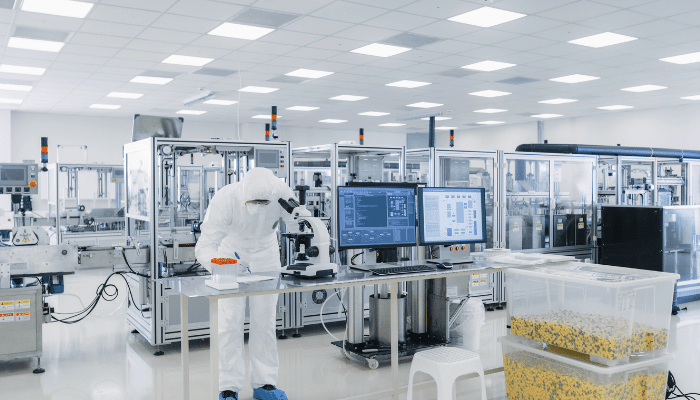Manufacturing reporting and data collection have always been important. The manufacturing sector is becoming more competitive each day. Manufacturers are constantly looking for ways to set themselves apart, make more revenue, and increase operational efficiency.
IIoT, manufacturing analytics, and smart manufacturing systems are great. However, a great number of manufacturers are not quite ready to jump in headfirst with these technologies. They want to improve but don’t want to make a substantial investment right out of the gate without knowing if it will truly help.
What do they turn to?
Pen and paper, and whiteboards. Manufacturing analytics and similar solutions have become more available and affordable in recent years, however, it is most definitely not at the same price point as a whiteboard and some dry-erase markers.
The question is, are whiteboards enough for manufacturing reporting today?
What Whiteboards can do for Manufacturing Reporting
Whiteboards definitely have benefits, and you can make a lot of improvements using a whiteboard system for manufacturing reporting.
You don’t want to be taking a shot in the dark, you need data to base your decisions on. Whiteboards can be the first step to becoming a data-driven company. Becoming a data-driven company is as important, if not more important than the technology itself. Whiteboard reporting gets you started on the process, and keeps you engaged.
You can have your operators record basic information periodically throughout the day. Choose certain metrics that need to be improved, track them, and start making your adjustments. Once you start tracking information, the numbers might surprise you. If you act on that data, you could start to see great results fairly quickly.
Isn’t this the goal of all of those fancy IIoT systems? Gather data, analyze it, make adjustments, and see the results? If you can accomplish this without investing in an IIoT solution for manufacturing reporting, do you really need one?
Why Whiteboards are Not a Long-term Solution for Manufacturing Reporting
Whiteboards are a great start, and great to get you into data-driven manufacturing. However, they have a low ceiling, and they can’t give you everything you will need down the road. Again, a great starting point, not a great long-term solution.
There’s a lot that whiteboards are missing. Unfortunately, it is a lot more than just seeing the data on a digital screen as opposed to a whiteboard.
Real-Time Data
With a whiteboard system, you could be finding data too late, missing your opportunity to make an improvement. When you record data manually, it is inevitably going to be at least slightly outdated information. There’s no way around it. At best, you might get to see data for the first time roughly an hour later, and that is if you are really on top of things and making the time investment to manually record and analyze that data quickly. Real-time data is a huge benefit with an IIoT/Manufacturing analytics system, however, it’s simply not an option with the whiteboard manufacturing reporting system.
Time Investment
It’s tough for your operators to manually record data. They’re smart, they know what they are doing, they hear noises, they can
Data for the Whole Plant Floor
It takes a lot of time to manually record sufficient data across the plant floor. Likely, you aren’t able to get consistent data on every single machine or piece of equipment. We have visited plants before and see a machine not turned on, not producing parts, not doing anything. We ask “Why isn’t that machine running?” Nobody has an answer, they have no idea why that machine isn’t running. The first problem here is that nobody even knew the machine wasn’t running. The second issue is that you don’t know why, or for how long. A Whiteboard reporting system will not help you here, because nobody knows or has any information on the how or why. The whiteboard system can really fail you here, especially as you continue to grow and have more and more machines, and equipment to keep track of.
A Centralized Solution
A centralized solution is a solution that is in front of everyone, available for everyone to see at any time. It should be easy for
Communication
IIoT is also a communication tool in a way. Let’s say you are taking really good notes as an operator, recording good data. How often does somebody actually come to you and ask for that data, and then react based on that data? Chances are not too often if at all, and definitely not in real-time. Then there is the data-entry time between people, which is a job all on its own when someone else wants to record that data for themselves. It’s just not efficient. You can have runners that go around the plant floor to record and share data between people, but just saying that out loud, does that really sound like a better solution?
Accurate Data with Product Changeovers
Many manufacturers have product changeovers multiple times a day. When you are using a whiteboard it’s hard to accurately adjust and record data when you are accounting for product changeovers. Every product will require a different process and take different amounts of time. You don’t want to mix them up and act on inaccurate data. Remember the goal is not to make as many adjustments as you can, the goal is to make the right adjustments that will actually make a difference. IIoT will seamlessly give detailed information on when each product was being produced, how long it took, and the efficiency during the production of each product.
Validating Data
Collecting data is easy, validating the data is tough. The data you collect is likely not going to be exactly what you expected, whether that is for better or worse. Many times manufacturers will completely disregard data because they don’t trust it. This is why you need a system that is reliable, consistent, and trustworthy with proven results. What would you trust more- basic information manually recorded by a human and analyzed at a later date, or real-time data changing instantly that is pulled directly from the machine itself? The bottom line is that you need data you can trust. If you gather data just to ignore it and cannot trust the data, you will never act on it and it will do nothing for you.
Operator Breaks
When using a whiteboard reporting system, say the operator is allowed to take a break during the hour, so at the end of the hour, you say that the operator should have produced x amount. But the data is inaccurate because there was a break in the hour that wasn’t accounted for. If you take the time, you could record these details manually with a whiteboard, but it’s a full-time job on its own to record extensively detailed data manually. This is just one more factor to think about that all add up to the whiteboard just not working long term. Again, whiteboards are great to start with, and great for finding the key metrics you want to track, but they are very limited.
Understanding Downtime
You are recording basic data. When you do encounter downtime, a lot of times the machine does not know why it’s down, and you have to figure that out. Whiteboard data is just too slow, basic, and overall inefficient. Frequently a machine will tell you that something is wrong, but it will just say “fault occurred.” That doesn’t really help, you need to know- was it a jam, did it get clogged up, or what happened? You need to have the data to understand the root cause of the problem as well as symptoms, not just that “it broke.” Manufacturing reporting with a whiteboard does not provide you with this amount of detail.
How to Determine where You are, and Your Next Step to Take
It depends on your specific goals and business challenge, but to excel and be the best, you need to equip yourself sufficiently.
What is the best starting point for you? Whiteboard or manufacturing analytics software? Here are some questions you can ask yourself to help determine where you are now, and what your next step should be on your journey to becoming a data-driven manufacturer.
If you had data sooner, what would you do differently?
Is there a lot of value in that time difference?
How often does somebody actually come to you and ask for that data, and then react based on that data?
Would it be valuable to have more key data or metrics than you have now?
If you were told that something is wrong, would you react right away to change it?
Would you like to get alerts or status information sooner such as a critical money-making machine is down?
Do your operators need to focus more on their job of manufacturing your products than entering data?
What’s Best for You?
If you were told that something is wrong, would you react right away to change it? Then use manufacturing analytics. Some manufacturers only make changes once a day unless it’s an emergency. This is not ideal or the most efficient, but it’s not uncommon, and much better than doing nothing at all. This will get you to 60-65% OEE, but it will not get you to 80-85%.
Real-time manufacturing reporting systems are good for the people who will actually react right away, if you get a real-time system and still just look at data and make changes one time at the end of the day, you are leaving a lot on the table, and not getting the most out of your investment.
Final Answer: Are Whiteboards Enough for Manufacturing Reporting?
The answer is that it’s situational. There is no one size fits all. It completely depends on your specific business challenge, and where you are in your data-driven manufacturing journey. A Whiteboard manufacturing reporting system has its place. Its place is for manufacturers who are still determining what metrics they need to track to make improvements. It can also be beneficial for manufacturers who are not ready to jump straight into a manufacturing intelligence/IIoT solution.
What’s important is collecting data that you are actually going to act on, which might go against conventional wisdom that says if the data is there, grab it. Sometimes it is good to gather all of the data possible if you don’t know what metrics are most valuable to you yet. Then narrow it down to what you will actually use.
Conclusion
You need to be able to measure if things are actually getting better based on the “improvements” you are making. It’s a maturity model- define where you are today, and then define where you want to be. Make sure everything you are doing is actually helping that cause. How much better could you be if you really spent the time and energy to improve? What’s your potential for improvement? Then map out what that looks like, and where to start first.




